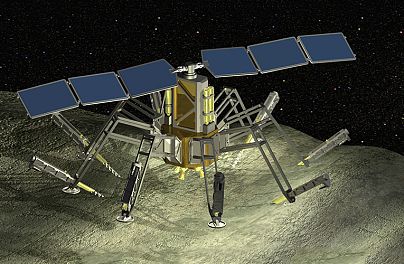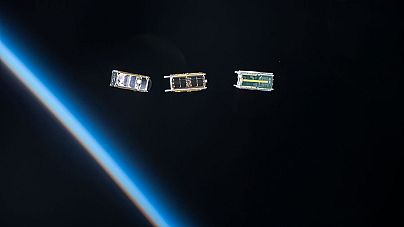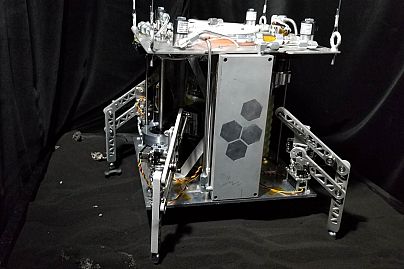The little spacebots could help make it routine for people to work in the asteroid belt or vacation at Saturn.
Philip Metzger has a vision. The 30-year NASA veteran wants to unleash a fleet of hopping robots — tiny spacecraft that would ply the solar system, map distant worlds and prepare them for the arrival of humans. And he wants the bots to refuel themselves on the fly, so they can just keep going and going.
At least that's the plan. The tangible reality is more modest: a prototype four-legged rover called WINE that Metzger, a University of Central Florida planetary physicist and a co-founder of NASA's Swamp Works innovation lab, and his collaborators at Brooklyn-based Honeybee Robotics demonstrated at Honeybee's California test facility on New Year's Eve.
WINE is short for "the world is not enough," since the spacebot's purpose is to help us move beyond our one-planet existence. It's about the size of a large toaster oven, and it looks a bit like one, too. Metzger and Honeybee vice president Kris Zacny designed it to land on an asteroid or moon, extract water from the surface and heat the water into a blast of steam that propels the robot to a new location until it has explored that little world and is ready to move on.
Since WINE makes its own propellant, Metzger says, it could keep exploring pretty much indefinitely. And in the process of scouting distant objects for water, it would collect detailed information about the composition and structure of every spot it touches. As Metzger puts it, "WINE would build up a master atlas of the solar system, filling in the information that later could be used by the scientists or the commercial guys."
Freeing a spacecraft from an earthly fuel supply could allow complex, long-duration missions, but Metzger has even bigger things in mind. He sees WINE as crucial to proving the viability of asteroid mining and, eventually, large-scale manufacturing beyond Earth. "We want to demonstrate what is possible with space resources, how to economically move industry off the planet," he says.
Swarming the solar system
A cornerstone of the WINE concept is cutting the cost of spaceflight. That's why the prototype is built from small, off-the-shelf satellites called cubesats.
"The target cost for the components is $200,000. We could get it to a few tens of thousands of dollars if we build enough of them," Zacny says. Universities could buy parts kits for WINE and let students assemble them as educational projects, reducing labor costs.
Zacny contrasts his approach with that of NASA's OSIRIS-REx spacecraft, which is currently exploring the asteroid Bennu. "OSIRIS-REx is a superb mission, but it's $750 million because everything is done by top-notch engineers at top-notch companies and universities," he says.
WINE would be less capable and reliable, but instead of launching one at a time it could be sent out in swarms numbering in the hundreds. If some failed, no worries. "If you have a lot of small spacecraft, even if 50 percent of them fail, then 50 percent of them move on and provide a lot of additional data points," Zacny says.
NASA itself sees the value of the approach; it provided a business-development grant to Metzger's team.
Interplanetary rock-hoppers
After launch, the WINE swarm would fan out to asteroids that have never before been seen up close. When a spacecraft reaches its target, it would land, mine the surface and then do a self-guided jump to the next spot.
"As you fill your water tank, you're analyzing the composition of the asteroids," Metzger says, citing an additional benefit of propulsion by local water.
With each move, a WINE would collect more details until it had thoroughly scouted out the object it landed on. The WINEs would need nothing more than solar energy to run their drills and to heat water into steam.
Upgraded versions of WINE could explore larger bodies like Jupiter's moon Europa — a prime location in the search for alien life. Metzger says a WINE mission to Europa might set out on excursions from a larger lander, bringing back samples for analysis by experiments built into the lander. But because of the strong gravity, WINE would be limited to short hops there.
On asteroids, comets and other small objects, which have feebler gravitational pulls, WINE could generate enough thrust to bound its way across the entire surface and move on to other objects.
Steam propulsion isn't powerful enough for multimillion-mile solar system journeys, but it could lift the robot off the surface so that a small solar sail could carry it to its next destination. Once there, WINE would resume its hopping adventures.
Birth of a robot ecosystem
In principle, each WINE could operate indefinitely — "forever," as some news outlets put it. In reality, the fleet would diminish over time. Some of the spacebots would fail to switch on or would break down along the way. Others would get stranded on objects that lacked enough water to power the next hop. That's all part of the plan.
Zacny says advanced versions of his robot could be designed to repair or upgrade themselves while in flight. "You can imagine that these WINEs could meet up, harvest subsystems from each other or combine forces by docking with each other to create a bigger spacecraft with more processing power," he says. "You can think of them as building blocks."
A central unresolved issue is who will pay for it all. Even if WINE robots become truly inexpensive, someone has to foot the bill and get them up on a rocket. "The entire thing hinges on having a market for the products of asteroid mining," says Andy Rivkin, an asteroid expert at the Johns Hopkins University Applied Physics Lab in Laurel, Maryland, who is unaffiliated with the project.
Metzger hopes his robot will help provide the answer. "The WINE spacecraft was conceived to be a microcosm of the space economy," he says. "You've got the mining segment, you've got the propellant depot and you've got the customer — the propulsion system — all on board the same spacecraft."
The same techniques used in WINE could be scaled up to create orbiting propellant depots for NASA science missions or for refueling commercial satellites, according to Metzger. Combine mining robots with 3D printers, and the WINEs could construct habitats and landing pads, preparing distant parts of the solar system for astronauts, adventurers and eventually an entire off-world industry.
"The end result," Metzger says, "is that humans never need to leave space, because space becomes truly affordable."














